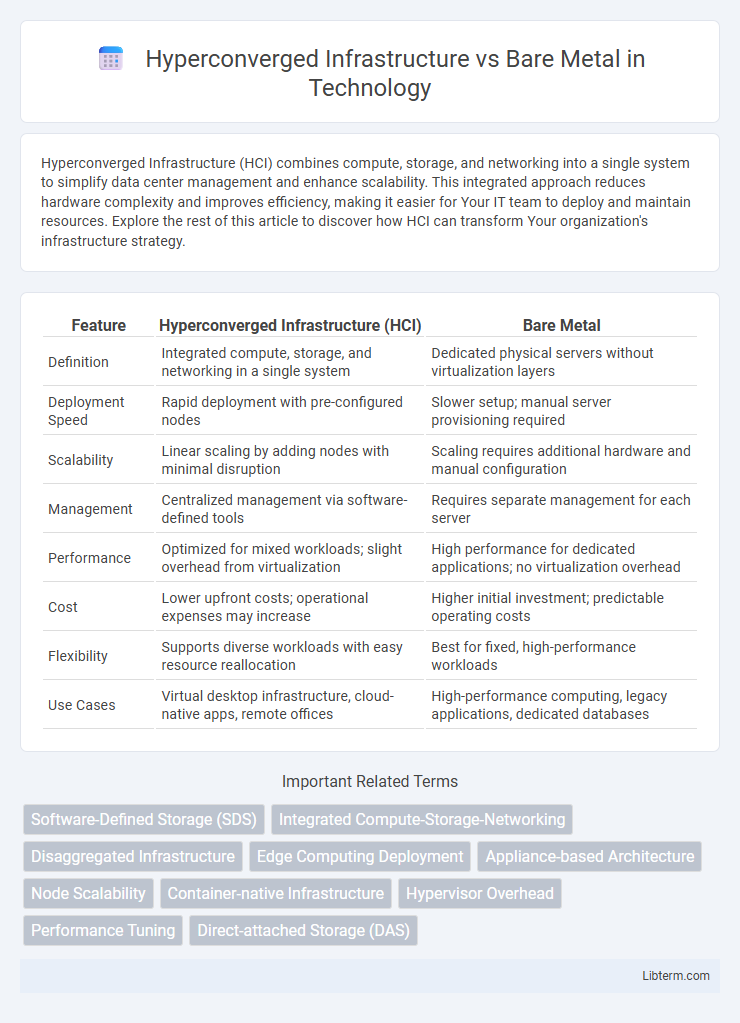Hyperconverged Infrastructure (HCI) combines compute, storage, and networking into a single system to simplify data center management and enhance scalability. This integrated approach reduces hardware complexity and improves efficiency, making it easier for Your IT team to deploy and maintain resources. Explore the rest of this article to discover how HCI can transform Your organization's infrastructure strategy.
Table of Comparison
| Feature | Hyperconverged Infrastructure (HCI) | Bare Metal |
|---|---|---|
| Definition | Integrated compute, storage, and networking in a single system | Dedicated physical servers without virtualization layers |
| Deployment Speed | Rapid deployment with pre-configured nodes | Slower setup; manual server provisioning required |
| Scalability | Linear scaling by adding nodes with minimal disruption | Scaling requires additional hardware and manual configuration |
| Management | Centralized management via software-defined tools | Requires separate management for each server |
| Performance | Optimized for mixed workloads; slight overhead from virtualization | High performance for dedicated applications; no virtualization overhead |
| Cost | Lower upfront costs; operational expenses may increase | Higher initial investment; predictable operating costs |
| Flexibility | Supports diverse workloads with easy resource reallocation | Best for fixed, high-performance workloads |
| Use Cases | Virtual desktop infrastructure, cloud-native apps, remote offices | High-performance computing, legacy applications, dedicated databases |
Introduction to Hyperconverged Infrastructure and Bare Metal
Hyperconverged Infrastructure (HCI) integrates compute, storage, and networking into a single system managed through a unified software platform, enabling simplified data center operations and scalability. Bare Metal refers to physical servers dedicated to a single tenant, providing direct hardware access without virtualization layers, offering maximum performance and control. Both approaches cater to different IT needs: HCI emphasizes agility and ease of management, while Bare Metal prioritizes raw processing power and customization.
Core Architecture: Hyperconverged Infrastructure Explained
Hyperconverged Infrastructure (HCI) integrates compute, storage, and networking components into a single software-defined system, simplifying management and scalability compared to traditional Bare Metal setups where hardware components operate independently. HCI uses virtualization and a unified management plane to pool resources dynamically, improving efficiency and reducing physical footprint. This core architecture contrasts with Bare Metal's dedicated hardware approach, which offers higher performance isolation but less flexibility and increased complexity in resource management.
Understanding Bare Metal Architecture
Bare Metal architecture provides direct access to physical server hardware, offering high performance and dedicated resources without virtualization overhead. It enables granular control over server components, ideal for workloads requiring maximum hardware utilization and low latency. Unlike Hyperconverged Infrastructure, which integrates storage, compute, and networking into a virtualized environment, Bare Metal delivers raw, unabstracted hardware for optimized, predictable performance.
Performance Comparison: Hyperconverged vs Bare Metal
Hyperconverged infrastructure (HCI) offers integrated compute, storage, and networking resources, providing streamlined performance with reduced latency in virtualized environments compared to bare metal servers. Bare metal servers deliver dedicated hardware resources, resulting in superior raw performance and lower overhead for high-demand applications such as big data analytics and real-time processing. Performance benchmarks consistently show bare metal outperforms HCI in I/O-intensive workloads, while HCI excels in scalability and management efficiency for mixed-use cases.
Scalability and Flexibility Considerations
Hyperconverged Infrastructure (HCI) offers superior scalability through integrated compute, storage, and networking components that can be expanded incrementally by adding nodes, enabling seamless growth without complex reconfiguration. Bare Metal servers provide high performance but scaling requires provisioning additional physical hardware, which can lead to longer deployment times and less flexibility in resource allocation. HCI's software-defined approach enhances flexibility by allowing centralized management and dynamic resource pooling, whereas Bare Metal environments demand manual adjustments and lack the agility required for rapid scaling.
Cost Analysis: Initial Investment and TCO
Hyperconverged Infrastructure (HCI) typically involves a lower initial investment compared to Bare Metal due to integrated hardware and software reducing upfront costs. Total Cost of Ownership (TCO) for HCI is often more predictable and lower over time because of simplified management, reduced maintenance, and energy efficiencies. In contrast, Bare Metal systems demand higher initial capital for specialized hardware and ongoing expenses for extensive IT administration and scalability upgrades.
Deployment and Management Simplicity
Hyperconverged Infrastructure (HCI) consolidates compute, storage, and networking into a single integrated system, streamlining deployment with pre-configured hardware and unified management software. Bare metal servers require separate installation, configuration, and integration of individual hardware components, leading to longer deployment times and more complex management. HCI's centralized management tools reduce operational complexity, while bare metal demands specialized expertise for managing disparate systems.
Security Implications and Risks
Hyperconverged Infrastructure (HCI) integrates compute, storage, and networking into a single system, enhancing security through centralized management and consistent policy enforcement, reducing attack surfaces and simplifying vulnerability patching. In contrast, Bare Metal servers offer dedicated resource isolation, minimizing risk from multi-tenant threats but require more complex security management and manual updates. Security risks with HCI include potential hypervisor vulnerabilities and shared infrastructure attacks, whereas Bare Metal risks involve physical hardware breaches and misconfiguration due to decentralized control.
Ideal Use Cases for Each Technology
Hyperconverged Infrastructure (HCI) is ideal for businesses seeking simplified management, scalability, and rapid deployment in virtualized environments, making it suitable for enterprises with fluctuating workloads or remote office deployments. Bare Metal servers excel in performance-intensive applications such as high-frequency trading, big data analytics, and gaming, where dedicated hardware and maximum compute power are critical. Organizations requiring granular hardware control and custom configurations typically prefer Bare Metal for achieving maximum optimization and low latency.
Choosing Between Hyperconverged Infrastructure and Bare Metal
Choosing between hyperconverged infrastructure (HCI) and bare metal depends on an organization's priorities for scalability, management, and performance. HCI offers streamlined deployment and simplified management through integrated software-defined storage and virtualization, making it ideal for businesses seeking flexibility and reduced operational complexity. Bare metal provides direct hardware access for maximum performance and customization, preferred in high-demand environments requiring specialized configurations or low-latency operations.
Hyperconverged Infrastructure Infographic

 libterm.com
libterm.com